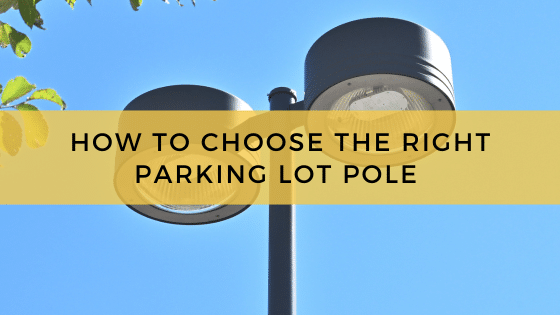
Parking lots require high quality night-time illumination to remain safe and functional at night. That starts with choosing the right parking lot lighting pole – one that will ensure even, adequate lighting coverage.
When choosing a lighting pole, the following factors need to be considered:
- Height
- Lighting distribution
- Material and construction
- Wind rating
- Fixture compatibility
There is a variety of lighting poles available on the market, so it may not be clear which is the best fit for your parking lot. This is where an experienced lighting company can provide expert help. Professional lighting installers know what types of parking lot lighting poles make sense for a particular project and can recommend the right option for a client.
4 Things Lighting Experts Consider When Assessing A Project For The Right Lighting Poles:
1) Height and Lighting Distribution
The height of the lighting pole is a primary factor in light distribution. The taller the pole, the wider the spread of illumination, so you will typically see the tallest lighting poles in the largest parking lots. Most parking lot poles range between 12 and 30 feet in height, but taller poles may be required for expansive parking lots.
The goal is to establish an even spread of illumination throughout the parking lot, as this promotes better visibility through the space. It also prevents hotspots or shadows, which can adversely affect motorist or pedestrian vision.
Lighting experts establish even illumination using photometric modeling software, which allows lighting designers to visualize the client’s space and simulate a variety of lighting solutions. It uses manufacturer data to simulate how a particular lamp emits light – its direction, and its intensity. With a bit of experimentation, lighting designers can develop a flawless lighting solution before mounting a single fixture – including identifying the perfect pole height and placement for the property.
2) Pole Material and Construction
Lighting poles are available in a few material choices – steel, aluminum and fiberglass are the three most common. Here is a quick comparison:
- Steel (including galvanized steel) – Steel offers superior impact strength and is a good choice for parking lots that see heavy or commercial traffic. However, unalloyed steel is susceptible to rust and corrosion, which is why manufacturers use galvanized steel in their lighting poles. Galvanized steel is a zinc-iron alloy that features improved corrosion resistance, giving it well-rounded durability. Steel is also less expensive than aluminum or fiberglass, so it offers an upfront cost advantage.
- Aluminum – Aluminum is the lightest of the three materials and is not quite as impact-resistant as steel. It can’t bear as much weight, either, but it is naturally corrosion resistant, so aluminum light poles tend to last longer than steel poles. Aluminum lighting poles are a good fit for parking lots located near the ocean, where airborne salts pose a constant threat of corrosion.
- Fiberglass – Fiberglass is the most expensive lighting pole material and doesn’t last quite as long as aluminum, but it offers comparable durability, is corrosion resistant and doesn’t conduct electricity. Fiberglass can be used interchangeably with aluminum in most parking lots.
Ultimately, your parking lot’s location and the traffic it receives are primary factors in choosing the right parking lot pole material.
3) The Lighting Pole’s EPA Wind Rating
Every lighting pole has an EPA (effective projected area) wind rating that specifies the maximum wind speed that the pole is expected to withstand before there is a high risk of failure. EPA wind ratings are based on the pole’s wind-exposed surface area, so size and shape must be reconsidered from every possible angle. This can make calculating wind ratings a challenge, but the difficult math has already been done for property owners.
The U.S. is divided into several wind zones, each one defined by the maximum wind speeds that wind-exposed structures should be built to handle. Houston, for example, sits in Zone III, an area where lighting poles must be fortified for winds between 110 to 165 mph. Property owners and their lighting installers should select a lighting pole that meets or exceeds this threshold, paying close attention to poles located near schools or medical facilities. The lighting expert will also help determine whether anchor-based or direct burial of the poles is the best option. Keep in mind that your lighting fixtures are also EPA-rated, so they will also need to be rated for your property’s region.
4) Poles that are Compatible with LED Fixtures
While most lighting poles are LED-capable, it is still worth verifying before installing anything. More parking lot owners are choosing LED lighting for their properties. There are several reasons for this, including improved energy efficiency, extended lamp lifespan (which means less maintenance and fewer lamp replacements), better lighting performance, and expanded controllability. In nearly every category, LED lights now surpass metal halides, high pressure sodium and fluorescent lamps in most areas – offering better night-time visibility, improved reliability, and greater installation flexibility.
For instance, LED lamps are now available in several light distribution options. Type III and IV LEDs are popular choices for parking lot applications because they throw illumination forward from the lamp, instead of pooling it around the base of the light pole. This gives installers a bit more flexibility in how they position lighting poles, and it may reduce the overall number of poles you’ll need.
The takeaway here is that it is bet to choose a set of poles that can accommodate LED lights.
A Reputable Lighting Expert Can Help Choose the Right Parking Lot Lighting Poles
Parking lots require adequate illumination through the night-time hours. To establish high-visibility, reliable lighting for their parking lots, property owners need the right lighting poles for the space. An experienced lighting installer can help their clients identify which poles will work best and use photometric modeling to position those poles for optimal lighting.






